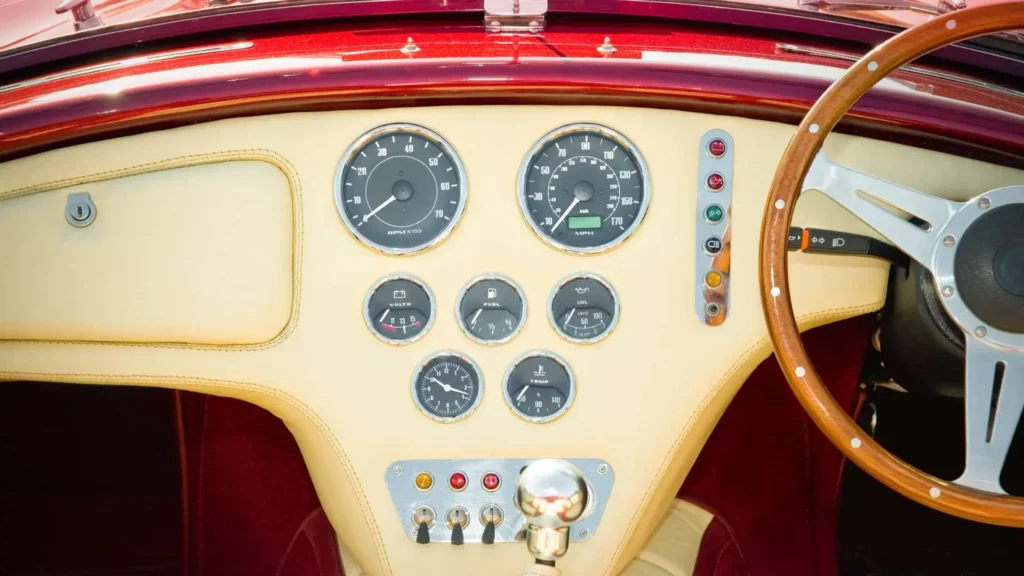Table of Contents
Introduction – Why Classic Cars Deserve Different Coverage
Owning a classic car is more than just a means of transportation. It’s a lifestyle. It’s a passion. It’s a piece of history. And for many owners, it’s also a serious financial commitment. This is why understanding the Classic Car Insurance vs Standard coverage is essential, as protecting a collectible requires a different approach than insuring a daily driver.
Think of a vintage Porsche 911. Or a fully restored 1969 Mustang. Or even a family treasure that has been lovingly cared for over the years. The value of these cars extends far beyond what typical auto insurance covers.
The problem here is that standard car insurance operates on depreciation to determine refunds. So, if your classic were damaged or totaled, the insurer would calculate the payout based on the “actual cash value” (ACV) of the car-the worth of the vehicle in the used car market today. For collector cars, this implies a payout that is significantly lower than the vehicle’s actual value.
This is where classic car policies come in. Rather than the standard ACV, the policies operate under the agreed value system, meaning the owner and insurer settle the worth of the car upfront and are paid for that price in the event of a loss.
Beem takes it from there to further streamline the process by helping owners compare insurers offering both standard and specialty classic coverage, ensuring you get the right protection at the right price.
What Counts as a Classic Car?
Not every old car automatically qualifies as a “classic” in the insurance world. The criteria can vary slightly between insurers, but most share similar guidelines.
- Age requirement: Typically, cars must be 20–25 years or older to be eligible. Some insurers extend coverage to newer vehicles if they’re rare, limited edition, or of special collector interest.
- Types included: Coverage usually extends to vintage, antique, muscle cars, hot rods, exotics, and other collector vehicles.
- Usage restrictions: To qualify, the car usually cannot be your daily commuter. Many insurers allow driving to parades, shows, club events, and occasional leisure use, but they expect the car to be stored securely and driven sparingly.
- Condition requirements: Insurers often require the vehicle to be in good or restored condition—sometimes backed by an appraisal or photographs.
So while your 22-year-old daily driver may technically be “old,” it probably doesn’t qualify as a classic unless it has collectible status.
How Standard Car Insurance Works
For everyday cars, standard auto insurance is designed to reflect the financial risk of a vehicle depreciating over time. The key principle is Actual Cash Value (ACV).
- Definition: ACV is the car’s replacement cost minus depreciation.
- How it works: If your car is stolen or totaled, the insurer calculates the value of a similar vehicle that would sell for on the open market. This means age, mileage, wear, and tear all reduce the payout.
Example:
Imagine you own a car purchased for $30,000. After years of daily driving, natural wear and tear, as well as depreciation, the vehicle’s market value has dropped to just $10,000. If the car is totaled in an accident, your insurer will typically only pay around $10,000—no matter how much money, time, and effort you’ve invested in keeping it in top shape.
For standard, daily-use vehicles, the actual cash value (ACV) model is applicable because these cars generally lose value over time. But when it comes to collectible classics, ACV severely undervalues the car’s true worth—especially if the vehicle has been meticulously restored, upgraded with rare parts, or is actively appreciating due to its collectible status.
How Classic Car Insurance Works
Classic car insurance flips the script by using Agreed Value coverage instead of ACV.
- Definition: Agreed value means you and the insurer determine the car’s value upfront, based on appraisals, condition, and market data.
- How it works: If the car is stolen or totaled, you’re paid the full agreed value, with no depreciation deductions.
Example:
Say you’ve fully restored a 1969 Mustang, and after careful evaluation, you and your insurer agree it’s worth $60,000. If it’s ever totaled, you’ll receive the full $60,000—not the $15,000 ACV a standard auto policy would calculate. That difference can mean everything when it comes to protecting both your money and your passion project.
This system provides genuine peace of mind because it recognizes the true value of a classic. Unlike everyday cars that depreciate, collectible vehicles are often appreciating assets with emotional and historical significance. Agreed value coverage ensures your financial investment, hard work, and dedication are protected accordingly, so you’re not left underinsured in the event of an accident or loss.
Key Differences – Agreed Value vs. Actual Cash Value
Valuation Method
- ACV (Standard Insurance): Depreciated market value. Often results in lower payouts.
- Agreed Value (Classic Insurance): Fixed, pre-set payout amount based on condition and appraisal.
Premium Costs
- Classic Car Insurance: Surprisingly, premiums are often lower than those of standard policies, because insurers account for the limited driving and lower accident risk associated with classic cars. A policy might cost between $200 and $600/year.
- Standard Insurance: Designed for daily use, so that premiums can be $1,000 or more annually for the same car.
Usage Restrictions
- Classic Policies: Typically restrict daily commuting. Driving is usually limited to events, exhibitions, or occasional pleasure use.
- Standard Policies: No restrictions—use the car daily.
Claims Process
- Classic Insurance: Straightforward—if the car is lost, you receive the agreed value.
- Standard Insurance: Disputes may arise over ACV, especially if you feel your car was undervalued.

When Classic Car Insurance Is the Better Option
Classic car insurance makes sense if:
- Your vehicle is a true collectible with increasing or stable market value.
- You drive it occasionally—to car shows, parades, or weekend outings.
- You’ve invested in restoration or customization and want guaranteed protection.
- You don’t want to risk getting a low-ball ACV settlement in case of a loss.
Essentially, if your car is more than just transportation, classic insurance ensures it’s valued as such.
When Standard Insurance May Be Enough
Not all older cars need classic coverage. Standard insurance may be sufficient if:
- The car is older but not collectible. A 15-year-old commuter sedan may be worth only a few thousand dollars and doesn’t qualify as a classic.
- It’s a daily-use vehicle. If you drive it to work every day, you won’t meet the limited-use criteria of classic policies.
- The car’s value is less than the cost of appraisal or agreed-value premiums.
In short, if your car is “old but ordinary,” standard coverage is typically fine.
Cost Comparison – Classic vs. Standard Policies
One of the biggest surprises for many owners is that classic car insurance is often cheaper than standard insurance.
- Classic Insurance: $200–$600 per year (limited use, collector value considered).
- Standard Insurance: $ 1,000 or more per year for a vehicle of similar market value.
Example:
- Restored classic: $40,000 Mustang.
- Classic insurance premium: $450/year (agreed value coverage).
- Standard insurance premium: $1,200/year (ACV coverage, lower payout if totaled).
Not only does classic insurance provide better payout protection, but it can also be easier on your wallet if the car isn’t a daily driver.
How Beem Helps Classic Car Owners Save
Choosing between standard and classic car insurance isn’t always straightforward. Some cars sit in a gray area—valuable but not quite rare enough, or collectible but still occasionally driven.
That’s where Beem comes in. Beem allows car owners to:
- Compare quotes from multiple insurers offering both standard and classic policies.
- See side-by-side savings between ACV and agreed-value coverage.
- Find tailored coverage that reflects your car’s actual use and value.
- Save time by avoiding calls, paperwork, and guesswork.
CTA: Check your classic vs. standard car insurance quotes with Beem today and protect your car the right way.
Conclusion – Protecting Value the Right Way
Classic cars are not merely vehicles; they are investment choices, heirlooms, and art. Bringing the right insurance policy to cover a classic car is crucial.
When you have standard insurance, they pay you Actual Cash Value (ACV), which means you might be shortchanged. Classic cars, on the other hand, use insurance that relies on the Agreed Value—the amount you and your insurer agree on from the beginning. This protects you by guaranteeing that you are paid fully.
The right kind of insurance brings peace of mind, whether you have a weekend cruiser, a restored muscle car, or a rare, world-class collectible. And Beem makes it easy-you don’t need to waste your time trying to figure out who can give you the best deal. Compare classic and standard coverage side by side to see the real savings, then choose the policy that accurately reflects your car’s value.
Final CTA: Depreciation should never be the reason why your classic car is undervalued. Compare classic vs. standard insurance quotes today with Beem and drive confidently.
FAQs – Classic Car vs. Standard Insurance
What qualifies a car for classic insurance?
Most insurers require a car to be at least 20–25 years old, well-maintained, and not used for daily commuting. Collector cars, antiques, exotics, and restored vehicles often qualify.
Do classic policies cover driving to work?
Usually, no. Classic car insurance is intended for limited use only—such as shows, parades, or occasional leisure drives. Daily commuting typically voids coverage.
Can I switch from standard to classic insurance during the policy term?
Yes. Many owners start with standard insurance and later switch once the car meets the qualifications or is restored to its original condition. Beem can help compare policies during the transition.
Is classic insurance always cheaper than standard insurance?
Not always, but in many cases, classic insurance costs less due to its limited use. Standard policies are usually more expensive since they assume daily driving.














































